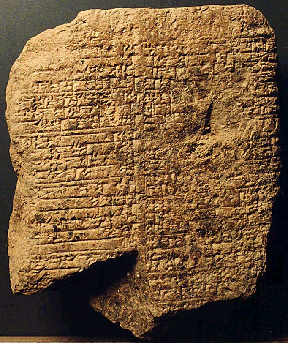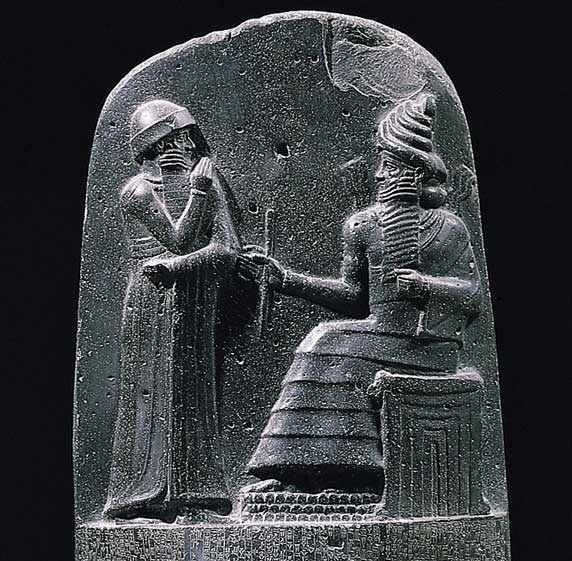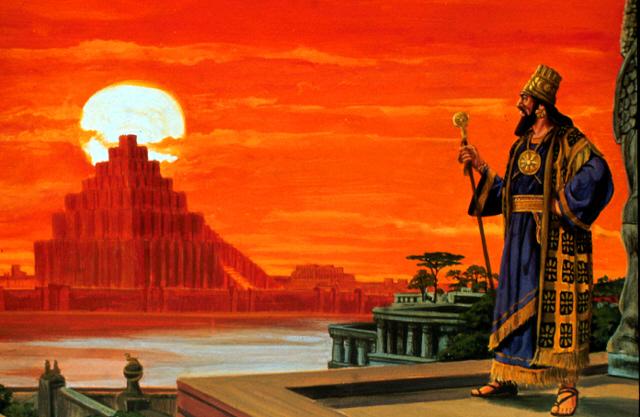Difference between revisions of "*History 8 Mesopotamia Notes"
(→10. What group was forced to move from Judah to Babylon? What was their social status?) |
|||
| Line 124: | Line 124: | ||
-Manual pages 89-90 | -Manual pages 89-90 | ||
| − | -Class Computer Exercise | + | -Class Computer Exercise |
| + | |||
| + | -Jaelynn Walls | ||
===11. How was the Semitic domination of Mesopotamia ended?=== | ===11. How was the Semitic domination of Mesopotamia ended?=== | ||
Revision as of 14:18, 16 November 2012
Return to Main Page History 8
Contents
- 1 1. What is the legitimation of authority ?
- 2 2. How was it practiced in Sumer?
- 3 3. How are bureaucrats, writing and the calendar connected?
- 4 4. Define Polytheism.
- 5 5. Was there a belief in the afterlife in Sumerian religion?
- 6 6. Define law and give its three characteristics.
- 7 7. What is Lex talonis?
- 8 8. How did the monarchy change during the Old Babylonian period?
- 9 9. Hammurabi's Code reflected a change in law. What was that change? Why important ?
- 10 10. What group was forced to move from Judah to Babylon? What was their social status?
- 11 11. How was the Semitic domination of Mesopotamia ended?
- 12 12. Why are the Hittites one of the most significant peoples in Mesopotamian history?
- 13 13. How did law change?
- 14 14. What was the Assyrian policy toward conquered peoples and what was the result of this policy?
- 15 15. How do we know about Mesopotamian culture, myth and literature?
- 16 16. What were some of the innovations in warfare begun by the Assyrians?
1. What is the legitimation of authority ?
The legitimation of authority occurs when the government operates as a form of authority where a person of group people hold power over the majority. In order for this system to work, the person or group of people must prove to the majority that they deserve the authority that they have.
- Nyla Jennings
Sources:
Notes on computer exercises
http://www.vanuatu.usp.ac.fj/courses/LA332_Jurisprudence/Articles/Hooker.htm
2. How was it practiced in Sumer?
Legitimation of authority was crucial to Sumer because it was a factor in uniting the first states in history. The Sumerian king was at first a king/priest, who was the leader of the government and also the leader of the religion. This was important to the king, as it allowed him to assert that he was chosen by divine selection. As time progressed, the Sumerians started to claim that he was divine himself, and that he was worthy to be worshiped. The Sumerians answered the question - Who deserves to have authority, and why? by claiming that their king was divine, sent by the gods to be their leader.
Citation: [2]
MLA Format:
Beniretto, Rosie. "Sumerians." Mesopotamia. St. John's School, 10 Nov. 2012. Web. 14 Nov. 2012. <http://www2.sjs.org/Beniretto/Mesopotamia/textcomputerexercise.html>.
External References:
The Sumerians - http://mesopotamia.mrdonn.org/sumer.html
Mesopotamian Government - http://mesopotamia.mrdonn.org/government.html
3. How are bureaucrats, writing and the calendar connected?
By Nina Lahoti
Bureaucrats, writing and the calendar are connected through the Sumerians, as they were all created by the Sumerians. They are also connected as bureaucrats required record-keeping, which required writing, and all of this administration required planning, so the calendar was made.
The bureaucrats, often called one of the best inventions ever made, was used for record-keeping whilst distributing things.
Writing was done in cuneiform, also known as wedge-shaped writing, which is the language that has been used for the longest time, other than Chinese.
The calendars were divided into twelve months based on the phases of the moon, and they illustrated the Sumerians' knowledge of astronomy.
4. Define Polytheism.
According to www.dictionary.com, polytheism is the "belief in more than one god or in many gods". Polytheism was first practiced by the Sumerians. Works Cited http://dictionary.reference.com/browse/polytheism?s=t Abigail Moorhead
5. Was there a belief in the afterlife in Sumerian religion?
Deleted incorrect information rb. The gods did not occupy some world existentially different from this one, and no rewards or punishments accrued to human beings after death. Human beings simply became wisps within a house of dust; these sad ghosts would fade into nothing within a century or so.
Zoroaster, one of the first to present the idea of one god, believed that those who were good went to a place of paradise and those who were bad went to a fiery hell.
 [3]
http://www2.sjs.org/Beniretto/Mesopotamia/textcomputerexercise.html#Sumerians
[3]
http://www2.sjs.org/Beniretto/Mesopotamia/textcomputerexercise.html#Sumerians
Picture from The British Museum Website.
Julian Chazz Nicholas Peavy
6. Define law and give its three characteristics.
Definition
Law is written and administered retribution and conflict resolution.
Characteristics
- Administration: Law is retribution that is administered by a centralized authority. This means that the punishment does not turn into revenge.
- Writing: Law is written; law assumes an independent character beyond the centralized authority that administers it. This makes sure that the law makers and the law administrators are not exempt from the law.
- Retribution Law is at heart revenge; the basic cultural way for dealing with bad behavior is to exact revenge.

Sources
http://www2.sjs.org/Beniretto/Mesopotamia/textcomputerexercise.html#SumerianLaw visited 11/13/2012,
http://schema-root.org/region/middle_east/iraq/national_library/ picture, viewed 11/13/2012
- Emily Pedrick
7. What is Lex talonis?
Lex talonis, basically law as retaliation, is the basis for Old Babylonian law. The phrase: "an eye for an eye, and a tooth for a tooth" shows the exact, and very harsh, penalties in Lex talonis, or the Law of Talon. For every offense, there was an equal counter punishment. For example, if someone killed someone else's mother, the other person would kill that persons mother for revenge. Lex talonis comes from Latin: "Lex" meaning "law" and "talonis" meaning retaliation. It is very common in more modern times too, as well as back then, reflected through Hammurabi's Code.
Sources
http://www.wordiq.com/definition/Lex_talionis
http://www.wordsmith.org/words/lex_talionis.html
http://www2.sjs.org/Beniretto/Mesopotamia/textcomputerexercise.html#SumerianLaw
Class Notes: 11-15-12
Manual 87
- Arisa Sadeghpour
8. How did the monarchy change during the Old Babylonian period?
In order to justify the enormous powers that the Babylonian monarch had, the Old Babylonians believed that their monarch was a god, and that he had a divine origin. This was a significant change in government. The new monarchy created new ways to run the state and its resources, such as taxation and military service. The greatest innovation that came with this government was centralization, where the monarch controlled all.
Manual Page 87
 ]
]
http://www.thelatinlibrary.com/imperialism/notes/hammurabi.html
-Sam Schneider
9. Hammurabi's Code reflected a change in law. What was that change? Why important ?
10. What group was forced to move from Judah to Babylon? What was their social status?
The group forced out of Judah into Babylon under the rule of Cyrus the conquerer of Persia were Jewish people. Most of these Semites were that of the upper class folk, and craftspeople. The relocation of up to 10,000 of these Jewish deportees marked the very beginning of "The Exile" as it was so famously dubbed. The relocation was made possible by the capture of Jehoiachin and Zedekiah, the two kings of Judah by Nebuchadnezzar, the son of Nabopolassar.
 Nebuchadnezzar, son of Nabopolassar.
Nebuchadnezzar, son of Nabopolassar.
Sources:
-Manual pages 89-90
-Class Computer Exercise
-Jaelynn Walls
11. How was the Semitic domination of Mesopotamia ended?
The Babylonians had previously overthrown the Assyrian empire. After the fall of Assyria, Nebuchadnezzar rebuilt the city of Babylon. However, throughout the city, there were still people loyal to the Assyrians. In 555 BC, the Babylonian Empire came under the rule of Nabonidus, a king loyal to the Assyrians. Nabonidus attacked the Babylonian culture, placing the Assyrian moon-god, Sin, above the Babylonian's principal god, Marduk, who symbolized the faith and people of Babylon. [1] The people faithful to Babylon became enraged, allowing the Persian king, Cyrus, into their city, ending the Semitic domination of Mesopotamia. [2]
Nabonidus, the last king of Babylon (555-539 BC)
Sources:
- ↑ CF Manual Pg. 90
- ↑ http://www.livius.org/ct-cz/cyrus_I/babylon01.html
- ↑ http://www.mesopotamia.co.uk/ziggurats/explore/cylinder.html
By Jeffrey Wang
12. Why are the Hittites one of the most significant peoples in Mesopotamian history?
The Hitties are one of the most significant peoples in Mesopotamian history because of their empire. Because their empire was so large and because their primary activity was trading with all the civilizations and peoples of the Mediterranean, the Hittites were primarily responsible for transmitting Mesopotamian thought, law, political structure, economic structure, and ideas around the Mediterranean. The Hittites are the great traders in the culture and adopted and modified by later peoples. Information from the Class Lecture.
Sophie Worscheh
13. How did law change?
Law started with the Sumerians around 5000 BCE. It had administration, writing, and retribution. Administration prevented a "cycle of mutual revenge, writing made the law somewhat permanent, and retribution is revenge. Sumerian law was based on Hammurabi's code, which is based on exact revenge: "An eye for an eye, a tooth for a tooth, a life for a life".Sumerian law also recognized class distinction, harming a priest was far worse than harming someone of a lower class. The sumerians fell around 2000 BCE and after them came the Amorites based in Babylon. They brought with them taxation and involuntary military service. Laws dealt with "crimes against the state". Next came the Hittites, who modified law majorly, at around 1600 BCE. Their laws were more merciful than the Babylonians. For example, murder was only a fine. Now instead of citizens owning private property, there was one king who owned all the land.
sources: http://www2.sjs.org/Beniretto/Mesopotamia/textcomputerexercise.html#SumerianLaw http://mesopotamia.mrdonn.org/sumer.html
Harrison Ray
14. What was the Assyrian policy toward conquered peoples and what was the result of this policy?
The Assuyrian policy forces all the conquered people to migrate to large areas of the empire to prevent revolts or fights. This helped the empire in many ways. one way it helped was it secured the empire. Another way it helped was by helping diverse all the other parts of the empire with cultures, languages, people, and different lifestyles. If the conquered people were not forced to deport then Mesopotamia would not be as diverse as it was because if the conquered people lived in the city states there would be minimum cultural conversing between the conquered people and the people who conquered them. This policy may have upset the conquered people but overall it heped Mesopatamia. http://www2.sjs.org/beniretto/Mesopotamia/textcomputerexercise.html#Sumerians
Sarah Grace Ritter
15. How do we know about Mesopotamian culture, myth and literature?
The monarchs of Assyria, who hated Babylon with a passion since it constantly contemplated independence and sedition, destroyed that city and set up their capital in Nineveh. Later, however, feeling that the Babylonian god, Marduk, was angry at them, they rebuilt the city and returned the idol of Marduk to a temple in Babylon. The last great monarch of Assyria was Ashurbanipal (668-626 BC), who not only extended the empire, but also began a project of assembling a library of tablets of all the literature of Mesopotamia. Thirty thousand tablets still remain of Ashurbanipal's great library in the city of Nineveh; these tablets are our single greatest source of knowledge of Mesopotamian culture, myth, and literature.
http://www2.sjs.org/Beniretto/Mesopotamia/textcomputerexercise.html#AssyriaReligion Jasmine Williams
16. What were some of the innovations in warfare begun by the Assyrians?
Some of the main innovations in warfare begun by the Assyrians were the inventions of metal armor, iron swords, lances, and battling rams. Science and mathematics became very popular in the Assyrian culture which helps the military with their warfare strategies and innovations. The greatest mathematical invention was the division of the circle of 360 degrees. The Assyrians also invented latitude and longitude lines for geographic navigation. Another major innovation was their sophisticated medial science that spread throughout all of Mesopotamia. These mathematical and scientific innovations were designed to benefit the military creating a very complex, intelligent warfare system.
Source:http://www2.sjs.org/Beniretto/Mesopotamia/textcomputerexercise.html#AssyriaFall
Grace Wilson
